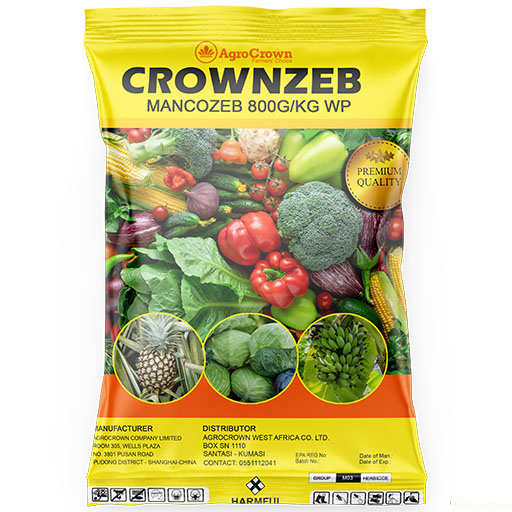CrownZeb

- AI: Mancozeb 800g/kg
- Target Insects: Contact fungicide with protective and curative action for control of a wide range of pathogens including blights and scabs on crops.
- Dosage: 50g-75g per 15L knapsack
1.Protective Clothing: Wear appropriate personal protective equipment (PPE) including long-sleeved shirts, long pants, chemical-resistant gloves, goggles or face shield, and chemical-resistant footwear. This clothing should be washed separately from other clothing after use.
2.Respiratory Protection: When applying insectides as a spray or in areas with poor ventilation, wear a respirator approved for pesticide use. Make sure the respirator is properly fitted and provides adequate protection against inhalation.
3.Mixing and Loading: Mix and load insectides in a well-ventilated area, preferably outdoors. Avoid spraying on windy days to prevent drift. Use designated measuring equipment and avoid spills during mixing and loading.
4.Application Equipment: Use properly calibrated and maintained application equipment to ensure accurate and uniform spraying. Follow manufacturer recommendations for equipment setup and operation.
5.Application Timing: Apply insectides when weather conditions are optimal, and avoid spraying during periods of high winds, rain, or extreme temperatures. Check weather forecasts and follow label instructions regarding application timing.
6.Buffer Zones: Maintain appropriate buffer zones around sensitive areas such as water bodies, residential areas, schools, and playgrounds as specified on the product label.
7.Storage and Disposal: Store insectides securely in its original container, away from food, feed, and other pesticides. Keep containers tightly closed and out of reach of children and pets. Dispose of empty containers according to local regulations.
8.Emergency Preparedness: Have an emergency plan in place in case of accidental exposure or spills. Know the signs and symptoms of insectides poisoning and seek medical attention immediately if exposure occurs.
9.Training and Certification: Ensure that applicators are properly trained and certified in pesticide application, handling, and safety practices. Stay updated on the latest safety guidelines and regulations regarding insectides use.
10.Record Keeping: Maintain accurate records of insectides applications, including dates, rates, weather conditions, and locations treated. This information can help track usage and minimize potential risks.
By adhering to these safety precautions, applicators can minimize the risks associated with insectides exposure and ensure the safe and effective use of this pesticide.
- Use a well functioning sprayer
- Use clean water, free of debris (sieve appropriately)
- Depending on the target insect’s activity, plant canopy and nature of infestation, use the appropriate nozzle.
- Double-rinse the knapsack sprayer and lance by pumping out clean water.
- Half fill the tank with water and add the appropriate dosage into the knapsack.
- For tank-mixed application with other compatible active ingredient(s), add the appropriate dosage of the other product.
- Fill the sprayer tank with water to 15L and mix the solution by pumping and spraying into the tank, while stirring.
- Ensure there is no leakage before mounting the knapsack sprayer.
- Direct spray mist to the target plant part and ensure enough chemical is dispensed onto the target area.
- For trials, always rinse the sprayer tank before the next dosage.